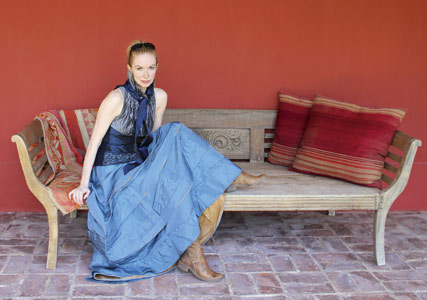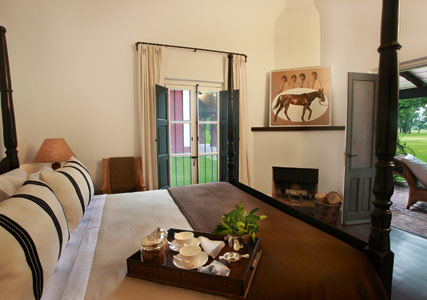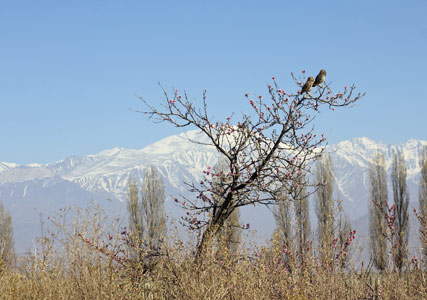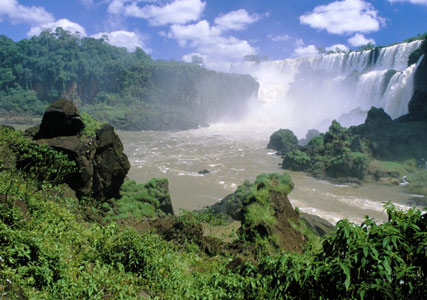The Big Trip: Argentina
Jan Masters falls in love with tango, wine and waterfalls on a ten-day whistle-stop tour

Jan Masters falls in love with tango, wine and waterfalls on a ten-day whistle-stop tour
It’s haughty. Haunting. And we hear it on the streets of Buenos Aires (aka BA) almost as soon as we arrive. Tango music. A girl with a sapling figure in a scarlet dress moves in staccato sync with a Brylcreemed boy, as if a dagger pierces their hearts and disengagement risks instant death. A mini-drama, magnetising crowds in San Telmo’s Sunday market, where antique shops, vintage stalls and tourist tat are crammed into a colourful barrio (district) of cobbled streets and crumbling mansions. What a place for our first glass of superb Torrontés wine…
Pictured: Jan Masters gets in the Latino mood
I’d long hankered to visit Argentina with my husband, Paul. This vast country seems to have it all: jungle lushness, rugged deserts, the fertile Pampas. The Andes mountains snake down its western border, glacier-jewelled Patagonia sparkles in the south. But unless you’re on a gap year, there’s only so much you can see in a single trip. We’ve elected for a ten-day whistle-stop tour taking in BA and its surrounding countryside, the western wine region of Mendoza, and the much oohed-about Iguazú Falls up in the far north-east.
Our base in BA for three nights is Palermo Viejo, a trendy barrio boasting hip boutiques and eateries, as well as our hotel, Legado Mítico, where every room is inspired by a famous Argentine (our broody interior channels writer Jorge Luis Borges). Contemporary, chic – it makes me want to rush home and redecorate. Another bonus is it’s near Don Julio, a restaurant loved by locals, complete with typical indoor asado (barbecue). Here, we tuck into our first Flintstones-with-finesse steak feast, followed by pancakes with dulce de leche, a caramel sauce that’s like catnip to most of the population.

Pictured: Hotel Legado Mitico
Suitably protein-powered, the next day we’re at large in BA, a port on the Río de la Plata with a cosmopolitan air. With its wide avenues, it’s often dubbed ‘the Paris of South America’. Indeed, visiting the swanky new dock, Puerto Madero, I spot more poodles per capita than on any stroll along the Seine.
Celebrity news, beauty, fashion advice, and fascinating features, delivered straight to your inbox!
But it’s not all pretty. Traffic coughs. Monolithic 60s/70s apartment blocks rub shoulders with elegant architecture. Graffiti is ubiquitous – some of it is Banksy-esque (hence bookable ‘art tours’), some politically driven. The general vibe, however, is welcoming and intoxicating, and we soon get into our own Latin rhythm. Wander. Pause. People watch. Chill out at cafes, such as the delightful terrace at modern-art museum MALBA.
We also lap up the must-tick tourist spots: La Boca, the down-at-heel southern barrio famed for its chroma-crazy corrugated iron dwellings and Argentina’s most-followed football team, Boca Juniors, where Maradona once played; and Casa Rosada in Plaza de Mayo, from where Eva ‘Evita’ Perón addressed adoring crowds.
My fave locale, however, is the dead-end of town − the Cementerio de la Recoleta, a 14-acre necropolis and final resting place of Evita. We stalk the marble maze of over 6,400 tombs and mausoleums, entranced by its eerie elegance, then emerge from its sanctity to noisy, sexy, confident Buenos Aires, feeling glad to be alive. It’s in this positive mindset that we drive 90 minutes north into the Pampas, home of heritage estancias (ranches) and the gaucho, that most romantic of Argentine characters, herding cattle, living in the saddle. Our two-night hitching post is La Bamba de Areco, a luxurified estancia near San Antonio de Areco, a staging post on the ‘Camino Real’ route to Peru since the 1830s. Driving up a long dirt track, we arrive at its imposing gates. They’re locked. What now? Then a handsome gaucho comes charging across the lawns on his steed, brandishing a key. As hotel check-ins go, it’s unforgettable.
Owner Jean-François Decaux keeps his cup-winning polo ponies in a colonial-style crimson building set in emerald fields. La Bamba doesn’t feel like a hotel – it’s more an elegant retreat, especially as all meals are included. Rooms are stylish yet unstuffy, staff attentive yet fun, and the chef conjures up treat after treat (we love his refined empanadas).

Pictured: La Bamba de Areco
Although it’s tempting to lie by the pool, we’re escorted on leisurely, non-challenging rides on mounts that are trained never to so much as trot with a visitor on their backs. We also visit the gaucho-authentic town San Antonio de Areco (ask for a tour with La Bamba’s Magdalena, a local school teacher and historian). Here we sit under orange trees and hang out with gauchos in pulperías − time-forgotten saloons-cum grocery stores. And we shop. I weaken at a silver ring (this is argent central) while Paul is measured for bespoke leather boots. Loved-up with Areco, we spend the evening dancing with locals and tucking into tapas.
Leaving La Bamba is tough, but BA’s domestic airport beckons for our two-hour flight west to Mendoza. It’s a cacophonous culture shock – we’re met with crowds and chaos, and the ground staff seem intent on giving us boarding passes to El Calafate in deepest Patagonia. Tip: turn up early and check all documentation.
Frazzled from airport frenzy, the atmosphere of Cavas Wine Lodge, nestling in its own vineyards in Luján de Cuyo, is ambrosial. Our home for three nights is an adobe-style room with plunge pool, rooftop terrace and a fabulously funky interior. On arrival we’re served the hotel’s own wine – and then we drink in our view, which is (drum roll) the snow-capped Andes.

Pictured: the Andes seen from Cavas Wine Lodge
From Cavas you can explore Mendoza, home to 70 per cent of Argentina’s wineries (harvest time usually starts in early March, but it’s picturesque all year). We hire a driver to show us the rugged landscape, marvelling at mini whirlwinds that toy with tumbleweeds. We stop for a gourmet lunch at nearby Bodega Ruca Malen. Sitting on the patio, contemplating the Andes, we relish five bijou courses plus petits fours, each paired with a generous ‘tasting’ of wine. At around £35 a head, it’s superb value.
For sporty types, this area offers hiking, riding, white-water rafting and kayaking. But we mainly just laze, enjoying tutored wine tastings and cooing at owls that in daytime perch on blossomed boughs, blinking and wondering why we’re so bewitched. On our final night we watch the sun blush behind frosted peaks, sipping rosé and slurping strawberries showered in balsamic vinegar.
From here it’s a four-hour flight northeast to Iguazú, where Argentina shows another spectacular face, this time in the humid, subtropical Parque Nacional, home to Iguazú Falls (from the native Guarani for ‘big water’). For approximately two miles, straddling the borders of Argentina and Brazil, some 275 waterfalls tumble over the rim of the Paraná Plateau, truly the kind of sight for which the word ‘awesome’ should be reserved.
They say Argentina creates the spectacle while Brazil enjoys the views, and to some extent that’s true. Exploring the Argentinian side involves riding a small train alongsidehordes of visitors through rainforests teeming with exotic animals (we even spy an alligator), as well as crossing walkways so we can get up close – and soaked. Wow! We gaze. We gasp. The power of the primordial waters is tremendous, and the most theatrical and thunderous of all is the Garganta del Diablo (Devil’s Throat), a horseshoe-shaped 269ft abyss.

Pictured: Iguaçu Falls
For our last two nights we hop over to Brazil and the five-star Hotel das Cataratas, a pink wedding cake of a colonial building with butterflies providing the confetti and arching rainbows the light show. A super-luxe hang-out with a panoramic view of Iguaçu Falls on your doorstep, it’s the sort of place where at night the bedroom turndown card not only tells you the weather forecast but also the volume of H₂O whooshing outside your window. On average it’s 330,000 gallons per second, but for us, it’s surging to 543,000.
What’s glorious about staying here is that you can have this wonder of the world all to yourself, before the tourist buses rock up. On our last evening, as Paul and I brave a catwalk jutting into the middle of the majestic maelstrom, we’re the only people there. I whoop into the mist as the thundering water cascades before us. Then we wave farewell to Argentina. Hydrotherapy – and holidays – just don’t get better than this.
Book Now
Audley Travel (01993 838 650; audleytravel.com) offers tailor-made trips to Argentina. A ten-day tour visiting Buenos Aires, San Antonio de Areco, Mendoza and Iguazú costs from £3,195 per person, including international and domestic flights, transfers, breakfast and three-star accommodation. A similar package staying at the luxury hotels mentioned here costs from £4,450 per person.
Recommended places to stay are Legado Mítico (legadomitico.com), La Bamba de Areco (labambadeareco.com), Cavas Wine Lodge (cavaswinelodge.com) and Hotel das Cataratas (hoteldascataratas.com).
Argentina (£16.99, Rough Guides) is a comprehensive guide, or see turismo.gov.ar.
The leading destination for fashion, beauty, shopping and finger-on-the-pulse views on the latest issues. Marie Claire's travel content helps you delight in discovering new destinations around the globe, offering a unique – and sometimes unchartered – travel experience. From new hotel openings to the destinations tipped to take over our travel calendars, this iconic name has it covered.